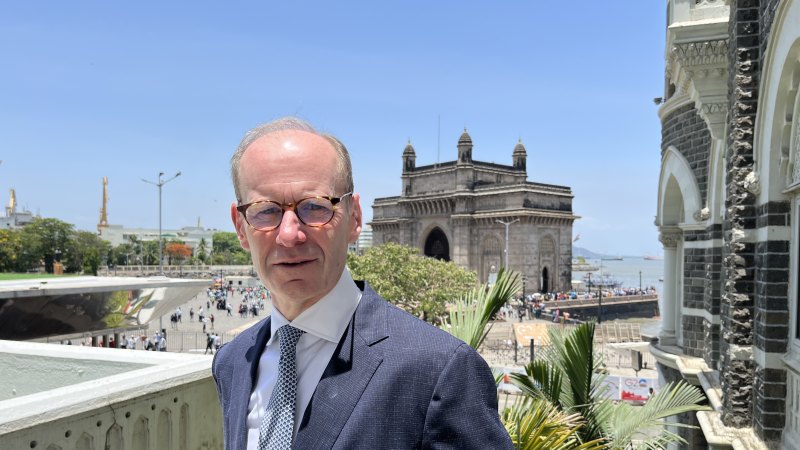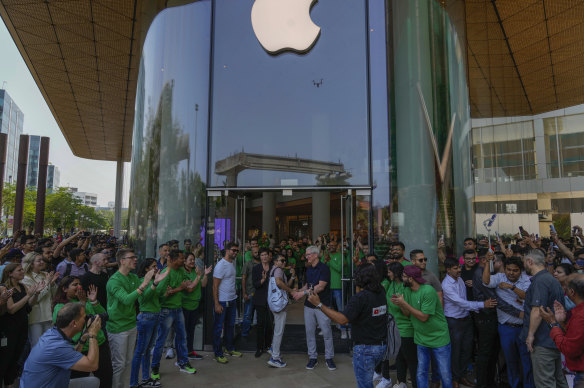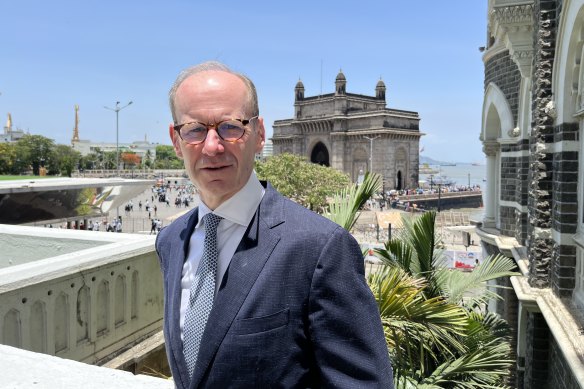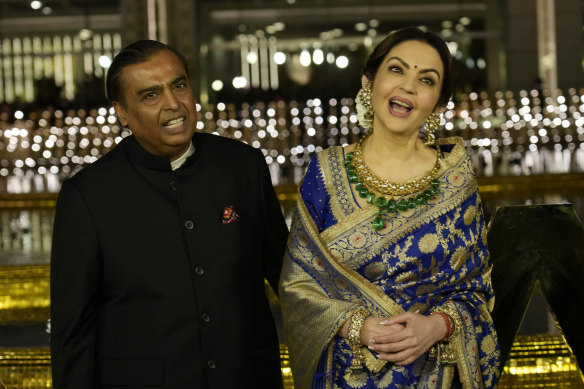‘We want to grow’: India’s wealth is exploding and ANZ wants a piece of the action
Save articles for later
Add articles to your saved list and come back to them any time.
It is hard to miss the signs of a booming consumer culture and displays of extravagant wealth in Mumbai, the finance capital of India.
The city is home to a mansion considered one of the world’s most expensive private houses, a 27-storey skyscraper, sales of Porsche sports cars are soaring, and when Apple opened its flagship store in Mumbai in April, it drew enormous crowds of customers.
Apple chief Tim Cook (centre) welcomes a visitor during the opening of Apple’s flagship store in Mumbai.Credit: AP
ANZ Bank chief Shayne Elliott, who was in India with the board of the banking giant this week, marvels that among the ultrarich Indian consumers buying these luxury Porsche cars, it is typically their seventh vehicle. While he acknowledges this represents a “very, very elite” part of the population, he is convinced India’s economy is undergoing a deeper change, and Australian businesses should take notice.
“The wealth effect has lifted a lot of people out of poverty. It’s pretty impressive. The middle class is just so huge now,” he says.
For years, businesspeople have been eyeing the vast potential of India – the world’s most populous nation according to the United Nations – but it has not quite delivered on that potential. ANZ is betting that this time is different.
“One of our customers yesterday said India has been perpetually pregnant, but this time it feels like the labour pains are real, and maybe we’re going give birth to something beautiful,” Elliott says.
This enthusiasm from ANZ, the only Australian bank with an Indian banking licence, comes as the two countries’ governments are pursuing closer ties. There was a high-profile visit to Australia from Indian Prime Minister Narendra Modi last month for meetings with Prime Minister Anthony Albanese, and a push for a free-trade agreement with India year’s end.
That’s despite criticism of the Modi government’s nationalist stance from some quarters.
In the past, business relations between Australia and India have been slow to take off, despite years of talk about India’s potential. So, what’s changed to get businesspeople such as Elliott so excited about India? What does that mean for ANZ’s wider strategy? And what are the risks that could derail to these bullish predictions for India’s economic potential?
India this year overtook China as the most populous nation, but when it comes to trade, India remains far behind our dominant export market, China. India is only Australia’s sixth-largest trade partner and it does not attract nearly as much attention in the business community as China.
Elliott wants to change this, and this week the board of the banking giant and the board of its New Zealand bank visited the country to see it up close and meet with stakeholders, regulators and its customers.
Some of the bank’s Indian clients are known to include conglomerate giant Reliance, run by billionaire Mukesh Ambani (who owns the 27-storey house); India’s fourth-biggest bank, Kotak Mahindra Bank; and payments business India1.
Elliott and his chairman, Paul O’Sullivan, point to changes that they believe have transformed India’s economy, making it increasingly attractive to ANZ.
First are the rapid technological shifts including the speedy embrace of digital payments, underpinned by an instant payment system that is crowding out cash among digital-savvy shoppers.
ANZ chief executive officer Shayne Elliott in Mumbai.
“The payment system in this country is more sophisticated than Australia,” Elliott says.
India’s tax system has been overhauled, and the economy has gradually been opened to foreign investors, who are keen to access its vast consumer market and tap into its large, educated, English-speaking workforce.
O’Sullivan points to enormous infrastructure investment, including the construction of metro lines, roads, and cites, and estimates that India’s middle class is between 300 million and 400 million people. “That’s a massive marketplace and a huge opportunity,” he says.
Traditionally, a key driver of foreign investment has been business processing – where foreign firms run their back-office and technology services in India. ANZ now has close to 8000 people in its technology services hub in Bengaluru, and rival Australian banks are setting up shop in India.
Multinationals such as Apple are also targeting India to diversify their manufacturing operations away from China due to geopolitical tensions and after harsh restrictions in China during the COVID-19 pandemic.
The prospect of a free-trade agreement between Australia and India has many in the business community excited. Last year, Australia signed an economic and trade agreement with India, which Austrade trade and investment commissioner John Southwell says gives exporters new opportunities to diversify.
“As a result, Austrade has seen a sharp increase in inquiries from Australian exporters looking to diversify and grow in the market with the tariff benefits already stimulating exports, including increased shipments of salmon, lobster, lamb, and premium wine to India,” he says.
ANZ is looking to cash in on India’s growing economic might through its institutional banking business, which banks major corporate clients, and has recently been a strong performer.
Over the years, ANZ has cut back on less profitable lending to some clients to focus on specialised activities such as trade finance, where ANZ believes it can beat rivals such as Citi or HSBC.
Elliott says ANZ is keen to grow its institutional business in India, though he stresses it is still a “very modest” part of the bank’s total exposure overall. It has about $500 million in capital in India, less than what it has in Hong Kong, Singapore or Japan.
“We’re profitable, growing business with real momentum, low risk from a customer point of view. So now we want to grow, absolutely,” he says. “And the reason to bring the board here is this is a great, it’s probably the best example, of that opportunity,” he says.
Institutional banking can be risky because of the large exposures to individual corporate clients, but Elliott argues its strategy of focusing on fewer, safer customers should mitigate this risk.
Billionaire Mukesh Ambani, chairman and managing director of Reliance Industries, and his wife Nita, owners of one of the world’s most expensive houses.Credit: AP
What about the economic threats to India’s rise?
Observers point to the political uncertainty over next year’s general election; the risk that high oil prices could spark inflation; and a decline in female participation in the workforce.
The inequality is also stark: Mumbai has enormous slums alongside immense wealth, and a large share of the country’s workforce is still in agriculture. It’s hard to miss the clear signs of overcrowding, and the huge job it has ahead to improve its infrastructure.
While the country is sometimes compared to China due to its sheer scale, Elliott also cautions that the two markets are very different.
China has a state-directed model that has produced extraordinary growth. India’s democratic system will inevitably result in a different type of economic growth.
“Most people would say this is not going to be a straight line, right? So, it’s going to be a bumpier road. It’s more likely to be two steps forward, one step back, kind of growth.”
The reporter travelled to India courtesy of ANZ Bank.
The Business Briefing newsletter delivers major stories, exclusive coverage and expert opinion. Sign up to get it every weekday morning.
Most Viewed in Business
From our partners
Source: Read Full Article




